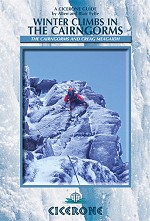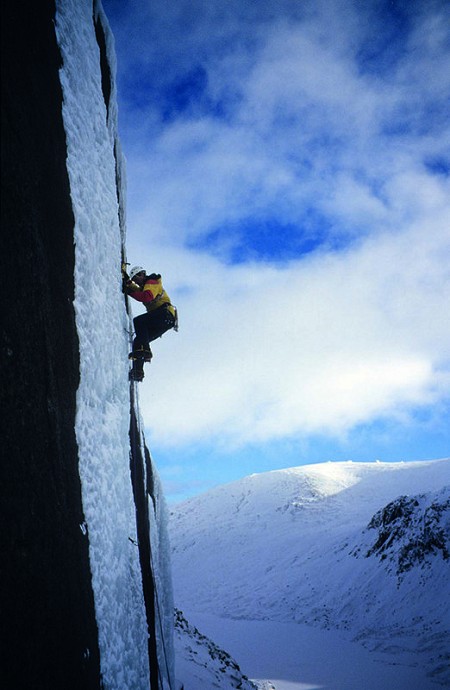

Published: 15 Dec 2011
Edition: Sixth
ISBN: 9781852846220
Price: £16.95
For more information or to purchase this book:
The major climbing venues of the Cairngorms provide some of the finest winter routes in Britain. From the remote corries of Braeriach and Beinn a'Bhuird to the magnificent cliffs of Lochnagar and Creag an Dubh Loch and the readily accessible Northern Corries of Cairngorm, every aspect of winter climbing is to be found here.
There is a complete range of various difficulties, lengths and styles in the Cicerone guide, from straightforward climbs to some of exceptional difficulty. Some routes are easily accessible, others are extremely remote but all require a solid mountaineering background.
Set in the heart of Scotland, the classic gully routes of Lochnagar are here as are the more remote and serious climbs on Braeriach. With something to suit all winter climbers, the Cairngorms has it all.
About the authors
Allen Fyffe has been an active mountaineer for over 40 years and has completed over 200 new routes in Scotland in both summer and winter. He has also climbed in Canada and Peru but is especially active in the Cairngorms.
Blair Fyffe has rock climbed extensively throughout Britain and Europe and has climbed new winter routes in Norway and new alpine routes in Kyrgyzstan. In 2006 he completed a PhD in slab avalanche release at Edinburgh University.
Sample Route - Coire an Lochain
NH 985 025
Altitude 1100m
North facing
This is the most westerly of the Northern Corries of Cairngorm and consists of a compact headwall of cliffs lying below the summit of Cairn Lochain and overlooking a huge pink slab – The Great Slab. This is a slope prone to avalanches and should be treated with caution.

The buttresses themselves are numbered 1 to 4, from left to right, and are separated by obvious gullies. On the left is The Vent, initially narrow but opening out into a wide funnel above; in the centre of the cliff is the wide diagonal of The Couloir; and tucked into the right-hand corner of the corrie are the two branches of Y Gully, separated by a narrow rock pillar. The rock in this corrie is very blocky and split by a succession of prominent crack and corner lines, which give some very fine mixed buttress routes.
Approaches
From the ski area car park in Coire Cas contour the Fiacaill a'Choire Chais, initially as for Coire an t-Sneachda, but take the lower track at the fork after a few hundred metres. Cross the stream and continue on one of several paths (not all shown on the map) which lead roughly south into the corrie. It is surprisingly easy to miss the corrie in bad visibility, and careful navigation is recommended in bad conditions. To gain the foot of the routes it is best to ascend the slope to one side or other of The Great Slab, depending on where your chosen route lies.
Descent
Follow the corrie edge, going roughly south-west, and descend back into the corrie to the north of the lochans or continue northwards down the ridge. The latter is safer when there is any avalanche risk. Alternatively, the Fiacaill Ridge can be descended or the plateau rim followed to eventually descend into Coire an t-Sneachda by the Goat Track or continue round and down the Fiacaill a'Choire Chais.
Conditions
This is a high cliff with its base at around 1100m. It comes into condition very quickly with snow and cold weather. However, good conditions can also extend well into the spring. Mixed routes are the first to be climbable, with the snow and ice routes taking a little longer to form. With a huge area of snow-collecting plateau above the cliff, there can be a substantial build-up of snow. This, combined with its northerly aspect and height, may mean that occasional routes, such as the branches of Y Gully, are climbable into June some years, while some of the buttresses may be good in October. Avalanches can be real hazard both below the cliff and from cornices and build-up at the top. The Great Slab is a notorious avalanche slope, and a huge full-depth avalanche occurs here each spring. At other times it becomes sheathed in ice, and it is worth avoiding this slope most of the time.
Number 1 Buttress
This buttress, the left-hand one, is cut by some deep and prominent corners; the right side is a steep wall overlooking The Vent. The front face is also steep, but merges into broken ground on the left.
Iron Butterfly 150m III
S Docherty and B Gorman, 31 December 1969
Climbs the more broken ground bounding the left side of the more continuous rock. Start in a huge open corner about 40m below and left of The Vent. Climb a groove in the corner to a ledge below an obvious crack in a steep wall. Go right and up snow to below another steep wall, then turn this on the left to reach more snow, which is climbed to the next steep wall. Go diagonally right to gain a wide gully, which is followed to the top.




Comments